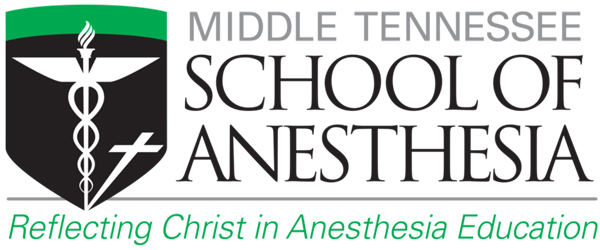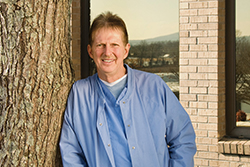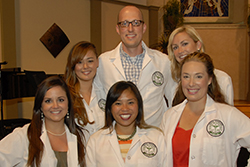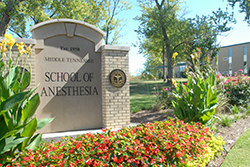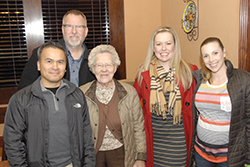Airways
April – June 2018
Scholarly Project Review
Improving interventions for dural punctures in obstetric patients
A review of MTSA alumna Maria Ledbetter’s scholarly project

Maria Ledbetter, DNAP, CRNA
With 20 years of experience in obstetric nurse anesthesia, MTSA graduate Maria Ledbetter (’97/’16), DNAP, CRNA, had seen her fair share of accidental dural punctures (ADPs) and was interested in pursuing better treatment options for her patients. That’s why she decided to embark on her Doctorate of Nurse Anesthesia Practice scholarly project, Factors Associated with a Decreased Incidence and Severity of Post-dural Puncture Headache in Obstetric Patients: A Protocol Development.
The purpose of Ledbetter’s study was to develop an evidence-based intervention protocol for the management of post-dural puncture headache (PDPH) as a result of ADP. She is a CRNA with Anesthesia Medical Group, based at St. Thomas Midtown Hospital in Nashville, which delivers upwards of 7,000 babies per year.
“Unfortunately, it’s somewhat common for a less experienced practitioner to accidentally puncture the dura during placement of an epidural catheter. This dural puncture with an epidural needle is also known as a ‘wet tap’ due to the large gauge needle and the leakage of cerebrospinal fluid from the needle hub,” Ledbetter said. “This leads to the post-dural puncture headache. It has always concerned me that these mothers go home with their new baby and have to deal with an excruciating headache and sometimes vision and auditory problems. It makes it difficult for them to care for their infant.”
Ledbetter points out that in a best-case scenario, the patient would have a headache before she left the hospital, and the anesthesia attending and CRNA administer a blood patch before the patient is discharged. However, more often than not, the mother goes home before PDPH presents—or it might present but not be extreme—so the patient comes back through the emergency department and must be re-admitted.
Research uncovers gaps
During her research of institutions across the nation, Ledbetter found that there was not a standard protocol for management of the patient with a PDPH. Anesthesiologists treated the complication differently, even within the same institution.
“Some would draw blood for the patch and place an IV to administer fluids after the procedure, some did not order an IV. It varied if doctors would want monitors when they performed the procedure and afterward. The amount of time a patient was kept on the unit lying supine varied. There was a large gap in the protocol to inform the patient and provide instructions after a known wet tap, as well as the follow-up procedures. In researching, I found out it’s not consistent at any institution,” she said.
According to Ledbetter, the epidural blood patch is still the “gold standard” treatment. However, other interventions exist to help alleviate the symptoms or the onset and severity without having to go through another epidural placement, which itself is not without risk of infection or other complications.
“I wanted to look at ways that we could standardize the management of PDPH so the anesthesiologists, nurse anesthetists, and nursing staff would have a standard protocol to follow,” she said. The literature cited studies that suggested the lack of a clear plan to manage the complication is what often led to the most dissatisfaction of the patient and the legal ramifications that followed.
The most significant findings of Ledbetter’s scholarly project include:
- Patients are at an increased risk of PDPH when, after an ADP, the patient pushes for over an hour for a standard vaginal delivery.
- Although more studies are needed, one promising intervention is the administration of neuraxial morphine mixed with preservative-free normal saline after delivery. In this case, the clinician leaves the epidural in place (assuming it was replaced after the initial dural puncture). Then approximately five hours after delivery, morphine is administered. For maximum effect, the epidural is left in place for 24 hours and a second dose of neuraxial morphine is given before the epidural catheter is removed. In some limited studies, this has proved very effective because patients experienced enough relief to be able to forgo the blood patch.
- Studies have shown gabapentin (Neurontin) and pregabalin (Lyrica) to be effective adjuncts.
- On the horizon is trans-nasal sphenopalatine ganglion block (SPGB), which can provide some relief for the headache symptoms.
- Studies showed that threading an epidural catheter into the intrathecal space and leaving it for 24 hours after a dural puncture did not decrease the incidence of a PDPH as previously reported.
Motivation for the study
Ledbetter wanted to study this topic due to the financial burden and safety risks incurred by patients. “It can increase your hospital length of stay and re-admission to the emergency department. This complication affects the whole family; it’s not only an expense, it is physically and emotionally draining. It also increases the workload of the anesthesia and nursing staff as the patient must be evaluated, treated, managed and followed up on in the future. It’s the most common complication of labor analgesia. In addition, there are no universally adopted protocols that include interventions other than routine blood patch,” she said.
A less invasive intervention for exploration, according to Ledbetter, is the use of neuraxial morphine: “This is not an intervention for which we would likely require lengthy IRB approval to study. It’s a drug that has already been approved for patients who have a C-section. When they have an epidural in place, we are already giving them neuraxial morphine for pain control. We also give this drug in the spinal (intrathecal) space when we administer subarachnoid blocks for cesarean sections, albeit in a much-reduced dose. It is a proven entity and safe. I thought, ‘Why are we not doing that in these cases and seeing if we can reduce the rate of patients requiring an epidural blood patch?’”
Ledbetter credits her advisors—Michael Vollman, PhD, RN, and Brett Clay, DNAP, CRNA, along with Amy Gideon, EdD—with helping her comb through a vast array of research related to epidurals. “Dr. Vollman, especially, helped me to stay focused and not ‘chase rabbits,’ as he enjoyed chiding me. It wasn’t always easy to read the statistics to determine what was a good study and what was not. He was an immense help with anything pertaining to research,” she said.
Going forward, Ledbetter hopes to stay abreast of new tools and simulator experiences to share with nurse anesthesia students and other CRNAs in order reduce the risk of ADP and subsequent PDPH. Her goal is to conduct additional research and promote a standard protocol that can be used at her institution and others.
“We need more research on neuraxial morphine and sphenopalatine blocks,” she said. “My goal is to discuss these issues with some of the doctors at my institution and implement a protocol that we can all use effectively and efficiently. I think it would be beneficial for the patients and clinicians.”
In addition to her part-time role with AMG at St. Thomas Midtown Hospital in Nashville, Ledbetter recently accepted a new position as a full-time assistant professor at Samford University in Birmingham, Ala. She graduated from MTSA’s Masters program in 1997 and from the DNAP program in 2016. She presented her scholarly project at the TANA meeting in 2016 prior to graduation and again at Samford University prior to employment.
President’s Message: Advancing evidence-based scholarship
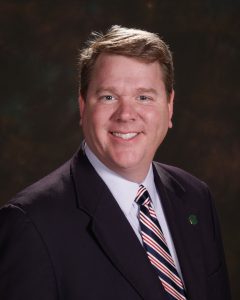
Chris Hulin
DNP, MBA, CRNA
President
One of the most recognizable traits of nurse anesthetists is our wholehearted dedication to patient care. We are passionate about making sure every patient is administered their anesthetic safely, and we know their lives depend on our commitment to clinical excellence.
With that in mind, I am pleased to see the progress we’re making in our efforts to help CRNAs become the leaders in acute pain management as it relates to curbing opioid use. As I wrote in my last column, we are in the process of developing a “think tank” where MTSA serves as a hub for advancing our practice.
I very much appreciate the feedback we’ve received thus far in the process. Many of you have offered input on how we can best use the physical space on campus—specifically the unfinished suite in the Magan Building—as well as the direction we should take with regard to further enhancing the body of knowledge and producing evidence-based scholarship as it pertains to the opioid epidemic.
As I submitted in an op-ed for The Tennessean newspaper, much of the public policy is rightly focused on treating opioid addiction. However, our profession can help an area that is often overlooked: prevention. Unfortunately, funding is this area is sorely lacking, and that needs to change.
As the baby boomer generation ages, increasing numbers of patients will undergo surgery, and CRNAs will be responsible for managing these patients’ acute surgical pain. Part of our job as nurse anesthesia professionals is to shine a spotlight on clinical interventions in this area.
Now more than ever, we need to let our voices be heard when it comes to the value of CRNAs in the fight against the opioid epidemic. I invite you to join me in raising awareness in our community about our efforts to promote evidence-based scholarship. Our patients deserve the best care, and we can lead the charge toward that end.
If you’d like to know more about our plans to be an aggregator for enhancing the body of knowledge in pain management—or want to be involved directly—please contact me at chris.hulin@mtsa.edu.
5th annual Mission & Awards Gala
Presented by Anesthesia Medical Group
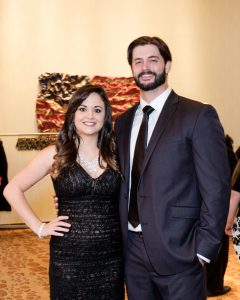


The 5th annual MTSA Mission & Awards Gala will be held Thursday, May 17, at The Westin Nashville.
The 5th annual MTSA Mission & Awards Gala presented by Anesthesia Medical Group will be held Thursday, May 17, at The Westin Nashville. Proceeds from the event benefit MTSA’s Mission Initiatives, including trips to Guyana and Haiti planned throughout this year.
According to event Chairman Jordan Miller (’11), CRNA, the evening will include a reception, dinner, award ceremony and entertainment featuring Nashville singer-songwriters “in the round.” The Gala is open to all including alumni, faculty, students, physicians, medical groups, corporations and individuals and is a celebration of the impact MTSA is making throughout the country and the world.
“New this year are silent auction items such as vacation condos in Aspen and Maui, gift certificates to local restaurants, hotel stays and many other items,” Miller said. Supporters who wish to bid on the auction items will have a chance to view them and get more information by visiting www.instagram.com/mtsa_gala ahead of the event.
Four awards will be presented as nominated by MTSA alumni and community:
- Mary Elizabeth “Ikey” DeVasher Alumni Distinguished Service Award: Stace D. Dollar, MS, CRNA
- Nevin Downs, MD Leadership Award: Brent Dunworth, DNP, MBA, CRNA
- Clinical Excellence Award: Juanita Turnipseed, MSN, CRNA
- Mission & Heritage Award: Angel Dawn Mangum, MS, CRNA
“It’s an honor to be the chairman of the Mission & Awards Gala. We have a great committee, and they’re working hard to ensure it’s a fantastic event,” Miller said. “All the proceeds go to help fund the mission initiative of the school, which is so important. In addition, it’s a way to bring together the anesthesia community and recognize people who are doing great work. There aren’t many platforms in our profession that allows for this type of recognition.”
Miller earned his Master’s from MTSA in 2011. He is currently enrolled in the DNAP completion program and works as the Lead Ambulatory CRNA at Vanderbilt University Medical Center.
For more information about the Mission & Awards Gala, contact the MTSA Advancement & Alumni Office at (615) 732-7674 or visit www.mtsa.edu/gala for tickets.
EVENT DETAILS
When: Thursday, May 17, 2018
Where: The Westin Nashville, 807 Clark Place, Nashville, TN 37203
Valet parking: $8
Reception/Silent Auction: 6:00 p.m.
Dinner: 6:45 p.m.
Entertainment: In the Round: Nashville Singer-Songwriters
Dress: Black tie optional
Ticket Price: $100 each
Table Price: $1,000 (10 guests)
Ticket Contact: (615) 732-7674
www.mtsa.edu/gala
Mission provided hands-on learning for students in Guyana
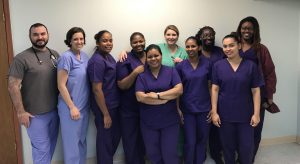
MTSA students Joseph Aikens (left), Morgan Rohde (second from left) and Callie Downs (fifth from right) traveled to Guyana with faculty and administrators to share their knowledge with nursing students at Georgetown Public Hospital System (GPHS).
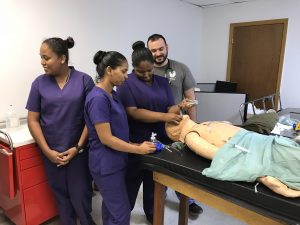
MTSA student Joseph Aikens provides hands-on simulation training at GPHS during MTSA’s mission trip to Guyana.
MTSA students and faculty recently returned from the first of three mission trips to the South American country of Guyana. The team taught and ran simulations with students in the nurse anesthesia program at Georgetown Public Hospital System (GPHS), in Guyana’s capital.
According to MTSA President Chris Hulin, the team delivered all of its lectures on iPads that were provided through funds raised at recent events such as the Mission & Awards Gala, Golf Classic and Sporting Clay Tournament.
“In the past the students at GPHS used a projector and took notes. We helped them download annotation software and provided all the lectures on their iPads. They were amazed at how much the technology was able to help them,” Hulin said.
Team delivered lectures and simulations
MTSA students delivered lectures on IV, inhaled and local anesthetics, along with simulations. MTSA Program Administrator Rusty Gentry, DNAP, CRNA, gave a detailed cardiac (including 12 lead EKG) lecture, while Hulin conducted board review lectures.
“This was our first trip to do this type of work in Guyana. It was eye-opening in terms of how the country’s educational system prepared its nurses for the nurse anesthesia program. Students entering the program have varying degrees of book knowledge, and none had received their bachelor’s degree,” Hulin said.
An important component of the trip was enabling MTSA students to model professional behavior and give the GPHS students a chance to see how that translates into patient care. “By having our students involved, you could just see the growth in their students. You could see a desire to model a higher level professionalism because of our students,” Hulin said.
Raising the standard of care
In addition to the GPHS students’ eagerness to learn, Hulin pointed out that they also wanted to know the differences between standards of care in the U.S. and in Guyana: “The students were all very interested in providing the highest level of care possible. They told us, ‘We are going to be the CRNAs that improve the standard of care in Guyana. We’ll be the ones to do it better because of what we’re learning here.’ The students also thanked us and gave the team parting gifts to show their appreciation for not only our work but for everyone who has supported the effort through donations.”
Hulin reported that the cohort at GPHS is the first group of CRNAs that will graduate and go back into the interior of the country where transportation and communication can be limited. For one student, in particular, it takes a couple days to get home via several boat trips through the rain forest. The local hospitals may have a surgeon visit once a month, which opens up the opportunity for continuing education around the county—something that MTSA has discussed with local agencies.
“We are working with the head of GPHS’s nurse anesthesia program, Alexander Harvey, MD, to provide test questions and pre-recorded lectures to help augment the program even further. In addition, we’ve been able to maintain connections through Facebook using a special page for the students to interact virtually,” Hulin said.
Volunteers needed for future mission trips
Additional teams from MTSA will travel to Guyana July 14-21 and Sept. 1-7. They will work with a new class as well as continue to work with the current cohort, including more of the clinical correlation and advanced disease processes.
“We are looking for volunteers to teach on our next two trips,” Hulin added. “If that interests you, we would invite you to join our team. Please reach out to me at chris.hulin@mtsa.edu, and we’ll provide all the details.”
Coming this fall: Golf Classic, Sporting Clay Tournament
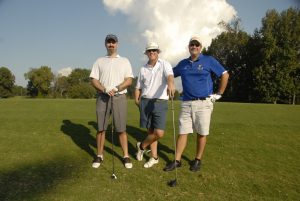
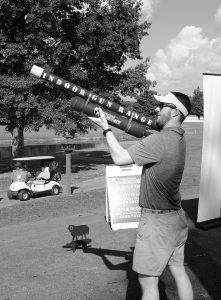
MTSA invites alumni and friends to participate in two upcoming events this fall:
15th Annual MTSA Golf Classic
Thursday, Sept. 20
Hermitage Golf Course – General’s Retreat
2nd Annual Sporting Clay Tournament
Friday, Nov. 9
Nashville Gun Club
The Golf Classic offers the chance to hit the links while supporting a good cause. Teams of four compete in a scramble format for prizes based on scores and special competitions on specific holes. Lunch and dinner are provided.
Last year’s inaugural Sporting Clay Tournament provided an opportunity for marksmen and novices alike to aim for greatness at multiple shooting stations at the Nashville Gun Club. Lunch will be provided, and prizes are awarded for those who hit the most clays.
“We’re so grateful to past participants of our Golf Classic and Sporting Clay Tournaments,” said Jim Closser, CFRE, vice president, Alumni & Advancement. “Everyone had a great time at both events, and we’re looking forward to bringing together more alumni and friends as we support vital mission work across the globe and locally.”
Proceeds from both events benefit MTSA’s Mission Initiative to Guyana, Haiti and other local communities.
Team registration and sponsorship opportunities are available now by visiting www.mtsa.edu/events and clicking on the specific event.
MTSA welcomes four new members to Board of Trustees
MTSA President Chris Hulin announced the school is adding four new members to its Board of Trustees: Brian Gelfand, MD, Jonathan Grooms, CRNA, Ken Schwab, EdD, and Jeff Whitehorn.
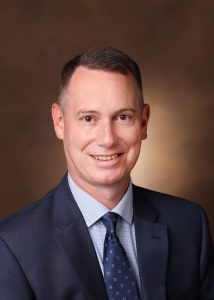
Brian Gelfand, MD
Anesthesiologist
Vanderbilt University Medical Center
Brian Gelfand, MD, is Associate Professor of Anesthesiology and Surgery in Vanderbilt’s Division of Cardiothoracic Anesthesiology. He is also Associate Vice-Chair, Educational Affairs, and Director of the Residency Program.
He completed a fellowship in cardiothoracic anesthesiology and was chief resident in anesthesiology at Brigham and Women’s Hospital/Harvard Medical School, Boston. He received his MD and MS degrees from University of Health Sciences/The Chicago Medical School, North Chicago, Ill., and his BA from Adelphi University, Garden City, N.Y.
Hulin said of Gelfand: “I’m thrilled to have a new Trustee on the Board who has a reputation from being a top-notch anesthesiologist. He not only supports but expects CRNA advanced practice.”
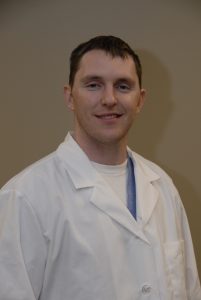
Jonathan Grooms, CRNA
Anesthesia Medical Group
Graduate of MTSA
Jonathan Grooms, CRNA, is Lead Cardiac CRNA with Anesthesia Medical Group (AMG) at St. Thomas Midtown Hospital (formerly Baptist Hospital) and Centennial Medical Center. He also serves as Clinical Instructor and Cardiac CRNA Education Manager for AMG.
He earned a Master of Science with Emphasis in Nurse Anesthesia from MTSA in 2006.
“As a fellow classmate in MTSA’s Master’s program, I’m glad to have Johnathan join the Board,” Hulin said. “He has an outstanding reputation as a cardiac CRNA as well as being a past instructor and long-time clinical coordinator for MTSA. It’s great to have him take the next step and join at a higher level within our institution.”
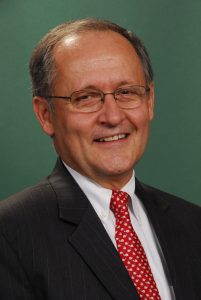
Ken Schwab, EdD
Former MTSA President
Ken Schwab was MTSA’s President from 2010 to 2015 and was an important part of the school’s growth during his tenure. Prior to MTSA, Schwab served as president emeritus and professor at Centenary College of Louisiana. He also was president and chief executive officer of Centenary College for nearly two decades.
Before joining Centenary College, Schwab held the positions of executive vice president for administration and executive assistant to the president for institutional planning at the University of South Carolina, where he also taught courses in education. Previously, he served in educational and administrative positions at Guilford College in Greensboro, N.C.
“I’m honored to have a mentor of mine, Ken Schwab, back ‘on board’ with MTSA,” Hulin said. “It really confirms his commitment to nurse anesthesia education and his love of the school and all it stands for.”

Jeff Whitehorn
Former CEO (retired)
TriStar Summit Medical Center
TriStar Southern Hills Medical Center
Recently retired, Jeff Whitehorn served as CEO of TriStar Summit for 14 years of his 29-year career in the healthcare industry. According to a statement from TriStar, he led expansion and growth efforts to meet the healthcare needs of the Hermitage area. He also led efforts to expand outpatient services at Summit Surgery Center; add outpatient imaging and diagnostic centers in Hermitage, Lebanon and Mt. Juliet; and bring radiation therapy to what is now Sarah Cannon Cancer Institute at TriStar Summit.
Whitehorn is an active member of Brentwood Hills Church of Christ, where he has served as a deacon since 2000. He and his wife, Jennifer, have two daughters, Ashleigh and Emily.
“We have been searching for some time to have someone of Jeff’s caliber from a hospital administration system. As a past hospital administrator myself, I’m pleased to have a stakeholder that can bring that unique perspective to the table so we can continue to meet the needs of not only the patients but health systems as well,” Hulin said.
Advanced cadaveric workshop helps hone skills
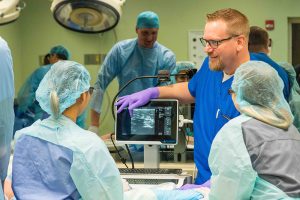
Last month, CRNAs from across Middle Tennessee converged for MTSA’s daylong Advanced Cadaveric Ultrasound-Guided Regional Anesthesia Workshop, which provided an opportunity for needling on pulsatile specimens.
The daylong workshop—centered on the “Maverick Method”—was taught by Bill Johnson, DNAP, CRNA, Director of the MTSA Acute Surgical Pain Management Fellowship; Stace Dollar, MS, CRNA; John M. Edwards, III, MS, CRNA; and MTSA Acute Pain Fellows.
“The workshop included ultrasound instruction, administration of block medium, and catheter insertions,” Johnson said. “In addition to classroom lectures, we used hands-on demonstrations and ‘live’ model scanning.”
Workshop attendees learned a variety of blocks, including fascia iliaca compartmental, adductor canal approach to the saphenous nerve, IPACK, PEC I/II, erector spinae, infraclavicular, costoclavicular, RAPTIR, quadratus lumborum, TAP (iliohypogastric/ilioinguinal, transversalis, and posterior TAP), and paravertebral, according to Johnson.
“MTSA’s Cadaveric Ultrasound-Guided Regional Anesthesia Workshop was excellent. I attended with several members of my CRNA-only group, and we all came away with a level of preparedness that has allowed us to expand the types of blocks we perform in our practice,” said Les Andrus, CRNA at Greeneville Anesthesia Services in Greeneville, Tenn. “The hands-on practice with pulsatile cadavers was indispensable. Having a pulsatile artery to work with is well-worth the time and money because that’s the main landmark for almost all blocks. The enthusiasm among all the attendees for everything we learned was contagious.”
Registration open for basic cadaveric workshop
Registration for MTSA’s Basic Cadaveric Ultrasound-Guided Regional Anesthesia Workshop on Sunday, April 29, is now open.
This eight-hour workshop is a hands-on, basic training course utilizing cadavers and “live” scanning models, state-of-the-art ultrasound technology, and a comprehensive, highly-practical approach to regional anesthesia techniques for surgery and acute pain management, according to Bill Johnson, DNAP, CRNA, Director, MTSA Acute Surgical Pain Management Fellowship.
Johnson, along with fellow instructors Stace Dollar, MS, CRNA, and John Edwards, MS, CRNA, will teach interscalene, supraclavicular, infraclavicular, axillary, distal upper and lower extremity salvage, fascia iliaca, femoral, adductor canal, and popliteal blocks using the “Maverick Method.”
Participants will receive the benefits of small-group needling stations, low faculty-to-attendee ratios, and an individualized learning plan that suits the attendees’ needs in regional anesthesia, Johnson said.
A discounted rate is available for MTSA alumni. For more information, visit www.mtsa.edu/events or contact Bill Johnson at (615) 732-7846 or bill.johnson@mtsa.edu.
MTSA hosts live video presentations on Facebook
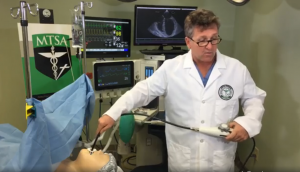
John Shields, DNP, CRNA
In January MTSA joined healthcare providers nationwide in recognizing the unique skills of CRNAs during the 19th annual National CRNA Week. The school hosted a series of live video presentations on Facebook—with nearly 2,000 views—which provided an opportunity to learn from a member of MTSA’s faculty and connect with other CRNAs.
MTSA Assistant Program Administrator Tatyana Aultman, PhD, CRNA, presented the topic Anesthesia for Opioid-dependent Patients. She touched on the importance of assessing patients’ needs and how to treat them appropriately based on their level of dependence.
“We need to know their doses. We need to know how often they take them. We need to know when they took that last dose, and we need to think about withdraw. Patients with chronic pain have a systemic issue. They have opioids on board. If we do not replace them, they will go into withdraw,” Aultman said as part of her presentation.
MTSA Director of the Acute Surgical Pain Management Fellowship Bill Johnson, DNAP, CRNA, offered a case study on paravertebral nerve blocks. He discussed a bilateral mastectomy for a patient that was undergoing surgery for breast cancer.
“This is a great example of a case where we combined multimodal management with regional anesthesia. We used five or six different multimodal medications, and she had a really phenomenal outcome. One advantage I see for the paravertebral block: it does probably provide the densest block. It’s only second to the neuroaxial technique. It gives you the opportunity to place catheters and follow [the patient] postoperatively,” Johnson said during his video discussion.
John Shields, DNP, CRNA, adjunct faculty, delivered a presentation on Incorporating Echocardiography into Your Anesthesia Practice using a “live” simulation in the lab.
After reviewing some of the basics of echocardiography training, he said: “Your interventions have been defined by something as simple as just a little bit of echo. The Council on Accreditation along with the AANA in 2014 decided that [echocardiography] was a part of our scope of practice. This is not part of the curriculum of any of our programs, so maybe it’s time to put it into our curriculum through simulation, workshops or a senior year fellowship. That is where we need to go.”
To watch the videos, visit facebook.com/MTSAnesthesia and click on the “Videos” link.
Alumni Updates & Events
Correction: In the last issue of Airways we incorrectly reported that MTSA alumnus Newell G. Brown (’64), CRNA, and his son Bevin Brown (’71), CRNA, were the first father and son to graduate from MTSA. In actuality, James H. Small (’52), CRNA, and James Samuel Small (’69), CRNA, were the first father and son to graduate from the School. MTSA considers each graduate a part of our family regardless of graduation date. Please accept our apologies. We are pleased to share this correction.
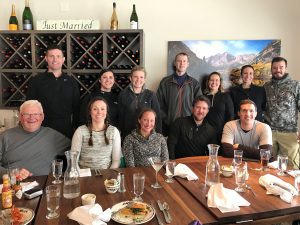
MTSA co-sponsored a luncheon for alum at the Holiday Seminars Snowmass conference. Pictured (l to r) are Bill, Stephanie Clark, Christal & Michael York, John Gambrel (first row), and Rich Maynard, Megan Waters, Emily Griesemer, David & Julie Murphy, Katie & Keven Keller (second row).
Events
This April, MTSA is opening its doors to both prospective employers and students to help further the careers of CRNAs. More information is available at mtsa.edu/events.
Tuesday, April 10
10 a.m.
MTSA Career Fair
Don’t miss this opportunity to meet, greet, and recruit MTSA students (future CRNAs) for your group, clinic, or hospital. MTSA will provide a table, two chairs, and lunch for each exhibitor. Cost: $50. For more information contact Pam Nimmo at (615) 732-7662, or pam@mtsa.edu.
Thursday, April 26
8 a.m.
Prospective Student Open House
Here’s your FREE opportunity to meet MTSA students, instructors, and administrators. You can participate in hands-on simulation demonstrations and take part in campus tours. Bring a friend or colleague.
MTSA Alum Needed for Mentor Program
Program enables alumni to provide professional expertise with current MTSA students
MTSA’s unparalleled alumni network provides opportunities for current students to learn about job markets and anesthesia groups in a student’s potential area of location after graduation. “We need alumni who would be willing to receive emails from current students who seek employment information,” says MTSA Assistant Program Administrator Leigh Taylor, MS, CRNA. ‘We know alumni mentors could give valuable career advice to them through long-distance communication such as email. As an alumni mentor, the frequency and form of communication would be up to your determination. Mentors do not have to be in Madison, Tennessee in order to give back to our students’ community; we invite all alumni to participate in this mentorship.”
For more information please contact Leigh Taylor at leigh.taylor@mtsa.edu or (615) 732-7850.
From the Archives: A Lakeside Graduation
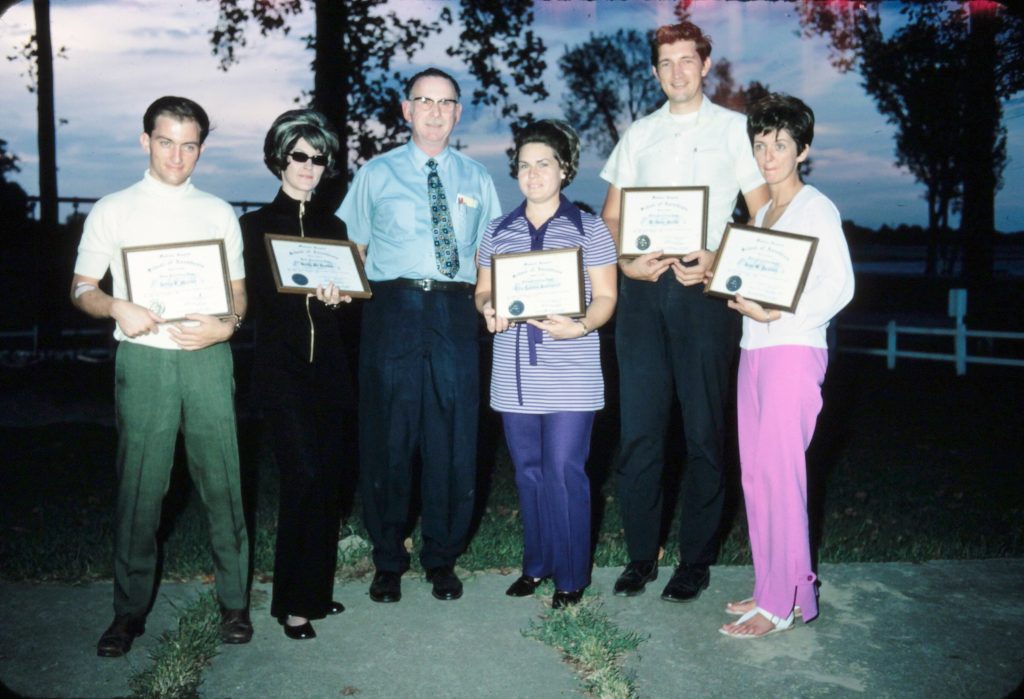
MTSA graduation ceremonies were often held at Old Hickory Lake. Our archive photo in this issue of AIRWAYS shows MTSA Director Bernard Bowen (middle with tie) and new MTSA certificate graduates from the class of 1970 (l to r) including: Jerry Mercer, Betty Jo Horton, Ella Louise Robinette, Gene Mende, and Jean Jackson. The influence of MTSA was felt in the states these alumnae worked including Florida, Oregon, Illinois, Kentucky, New Mexico, Alabama, and Tennessee.


